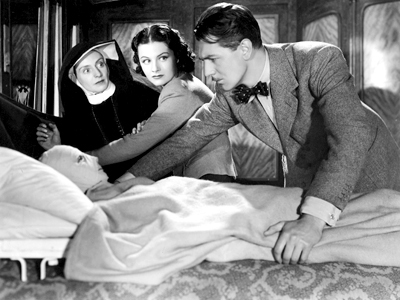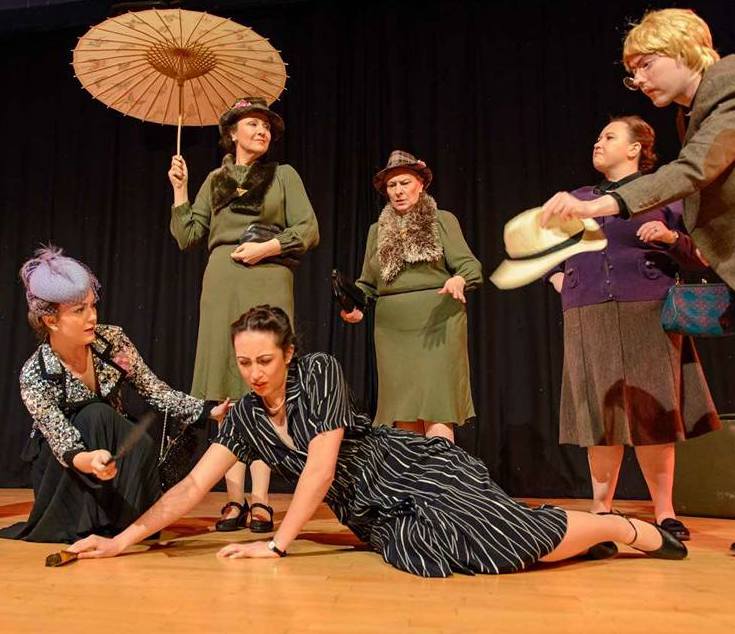The Lady Vanishes

9F, 8M (8F, 5M with doubling) Running Time: 90 minutes
The famous Alfred Hitchcock classic specially adapted for the stage in this new comedy thriller
The classic 1938 8Hitchcock film ‘The Lady Vanishes’ was based on a novel called ‘The Wheel Spins’ by Ethel Lina White. It took various liberties with the plot, including introducing a propaganda element involving Nazis.

The play has been written so that there is a continuous sense of action, moving seamlessly from one scene to the next as far as possible. The various different ‘sets’ are all on stage throughout and lit as appropriate.
The story: Iris Carr is a wealthy socialite and we first meet her as she faints with sunstroke waiting for a train to take her back to the UK after holidaying in Eastern Europe. Once on the train she is in a compartment with a ‘honeymoon couple’, an austere Baroness, a formidable looking ‘Doctor’, and an elderly lady with an eclectic dress sense – Miss Froy.
She befriends Miss Froy who tells Iris that she was a governess for an important family in Moldavia, but is now between jobs and is journeying back to England to spend some time with her parents.

Shortly after, Iris falls asleep and, when she wakes, is surprised to find that Miss Froy is no longer there. But, when Iris asks the others where Miss Froy has gone, she is astonished that they deny she was ever there! Unable to comprehend this, she goes out in search of Miss Froy and meets up with Max Hare and his friend a Professor. Together they agree to help Iris find Miss Froy but soon begin to doubt her word as they are met with denial from everyone they talk to.
Then the Doctor announces that her has found Miss Froy – she was in the next
compartment all the time. Delighted Iris rushes to the compartment to discover it’s an entirely different woman altogether: Frau Kummer. A woman dressed as Miss Froy. ‘That's not Miss Froy!’ declares Iris at the end of Act 1.In Act 2, Iris enlists the help of the Reverend Barnes’ wife who remembers seeing Miss Froy, but she – to Iris’ dismay – identifies Frau Kummer as Miss Froy. Max, it seems, is Iris' only ally. He encourages her to try to remember any clues, and Iris remembers a story Miss Froy told her about her previous employer, who was accused of corruption by the political opposition.
Max produces has a local newspaper he found in the restaur

By now Iris is beginning to doubt herself and fears she may be going mad. But then she discovers Miss Froy has written her name in the dirt on the compartment window where she was sitting. Meanwhile the Doctor has convinced the Professor and others that Iris should be taken to one of his care homes in Trieste when the train arrives, for her own safety.

The last scene takes place at Trieste station with the arrest of the Doctor and Frau Kummer, but not the Baroness. We understand more about why other passengers were reluctant to confirm that they had seen Miss Froy. And the play ends with a happy outcome for Max and Iris.
Characters in order of appearance
Iris Carr (20s-30s): Wealthy, headstrong but very likeable and sociable young woman
Todhunter (40s-50s): Blustering, domineering man, actually Lord Brown incognito
‘Mrs’ Todhunter (40s-50s): Actually Mrs Parmiter, having an affair with Lord Brown
Miss Evelyn Flood-Porter (50s-60s): Very opinionated, rather overbearing woman
Miss Rose Flood-Porter (40s-50s): Her sister, less overbearing but just as opinionated
Rev. Kenneth Barnes (30s-50s): Amiable, but rather ineffectual and sickly vicar
Mrs Barnes (30s-40s): His wife – who wears the trousers – a definite chatterbox
The Baroness (50s-60s): Austere, dominant character you don’t want to mess with
The Doctor (40s-50s): Rather creepy, bearded Eastern European ‘doctor’
Waiter (30s-50s): Friendly, tries to be helpful, but probably quite lazy
Nun (30s-50s): Slightly mysterious and anonymous character
Miss Froy (50s-60s): Warm hearted, gregarious and generous woman
The Professor (30s-60s): Slightly pompous but warm, doesn’t like to be proved wrong
Max Hare (20s-30s): Cheerful and very capable young man
Frau Kummer (30s-50s): Stern Eastern European and hardly a barrel of laughs
Border Official (30s-50s): Small part in one scene
Porter (40s-50s): Small part in last scene
Note: Waiter, Border Official and Rev. Barnes can be easily doubled, as can Frau Kummer and the Nun, and Todhunter and the Porter
The Lady Vanishes is available for performance from Stagescripts.
For a pre-publication perusal copy of the script, click here: stagescripts.com
